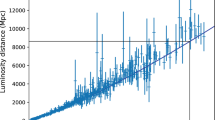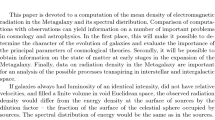Summary
The accelerationa 0∼10−8 cm s−2 appears insistently in physics and seems to play a fundamental role at the cosmological, astrophysical and microphysical level. It is the surface gravity of all mesons, of a typical protostar, of a typical galaxy and of the entire Universe; it is also the minimal acceleration an electric charge must have to radiate, the minimal centripetal acceleration of the quarks trapped in a spinning meson, the minimal acceleration a frame must have to feel the Unruh temperature, the minimal value a gravitational field must have to induce transitions between states of opposite parity in the hydrogen atom, the acceleration of any particle of rest massh/Rc (R= the radius of the observable Universe) such as the graviton; from the existence of the fundamental accelerationa 0 one can derive the Weinberg relation (connecting microphysics to cosmology) and the well-known rough equality (so far unexplained) between the energy density of the cosmological microwave radiation, of the mean galactic magnetic field, and of the starlight in the Milky Way.
Similar content being viewed by others
References
C. Massa:Lett. Nuovo Cimento,44, 609 (1985).
E. Fischbach:Tests of general relativity at the quantum level, inCosmology and Gravitation, edited byP. G. Bergmann andV. De Sabbata (Plenum Press, New York, N.Y., 1980), p. 359.
C. Massa:Lett. Nuovo Cimento,44, 695 (1985) and references therein.
P. Caldirola, M. Pavsic andE. Recami:Nuovo Cimento B,48, 205 (1978), see pp. 212, 216, 233.
C. Sivaram andK. P. Sinha:Phys. Rep.,51, 111 (1979).
—See ref. [4] and references therein.
For the Schuster relation, see:S. P. Sirag:Nature (London),278, 535 (1979);C. Massa:Ann. Phys. (Leipzig),46, 156 (1989) and references therein. For the Brosche relation, see:P. S. Wesson:Phys. Rev. D,23, 1730 (1981) and references therein;V. Trimble:Comments Astrophys.,10, 27 (1984).
L. J. Tassie:Nature,40, 323 (1986).
K. Gottfried andV. F. Weisskopf:Concepts of Particle Physics (Oxford, 1984), 2nd volume, p. 404.
—See ref. [5]. and references therein; see alsoH.-J. Treder:Found. Phys.,15, 161 (1985).
C. Isham, A. Salam andJ. Strathdee:Phys. Rev. D,3, 867 (1971).
V. De Sabbata andM. Gasperini:Lett. Nuovo Cimento,24, 215 (1979).
Author information
Authors and Affiliations
Rights and permissions
About this article
Cite this article
Massa, C. Is there a fundamental acceleration?. Nuovo Cim B 109, 25–33 (1994). https://doi.org/10.1007/BF02723726
Received:
Accepted:
Published:
Issue Date:
DOI: https://doi.org/10.1007/BF02723726




